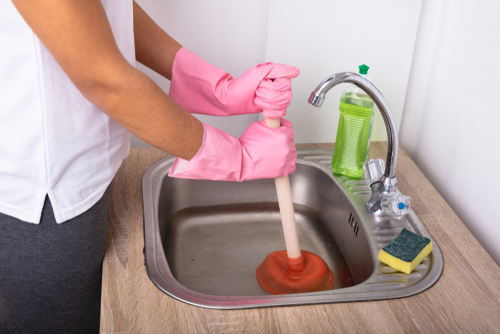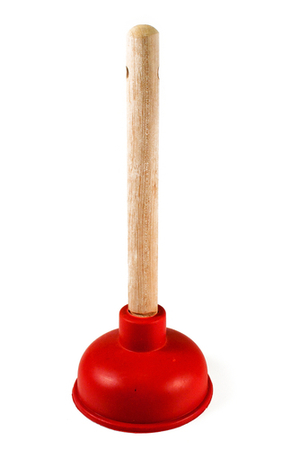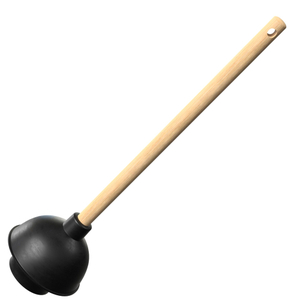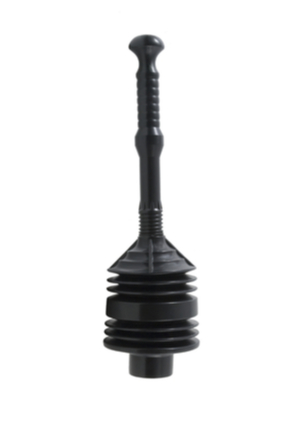June 5, 2025
Types of Toilet Plungers [Video]
Plungers are the go-to household tools for dealing with drain clogs. That’s because they’re inexpensive and easy to use. But did you know that there are different types of plungers, each for different types of clogs? Knowing which type to use will greatly increase your chances for success.
In this guide, we’ll cover the three main plunger types: the sink plunger, the toilet (or flange) plunger, and the accordion plunger. At Applewood, we want to be your Colorado plumbing experts. Sometimes that simply means showing you the best type of plunger for the job.
How Does A Plunger Work?
Plungers work via physics, specifically Boyle’s law. This law states that if the volume of a gas increases, the pressure decreases, and vice versa, as long as the temperature is constant. Think of squeezing a balloon; you decrease the volume that the gas occupies but increase the pressure inside the balloon.
In the context of unclogging drains, this principle is applied to create a change in pressure that helps dislodge the blockage. When you position a plunger over a drain and press down, you’re effectively decreasing the volume of air between the plunger cup and the drain opening. This increases the pressure inside the pipe and pushes the water downward. When you pull the plunger upwards, the opposite happens: the volume increases, pressure decreases, and a vacuum is created. This vacuum can help pull the clog material away from the drain walls, loosening it. This “sloshing” motion dislodges most clogs after a few spirited turns.
How to Use a Plunger: 3 Tips

Plunging a toilet isn’t rocket science, but it can be tricky if you’re new to plunging. Here’s how to get the best performance out of your plunger:
Seal and Fit
The plunger must form a tight seal around the drain opening. A good seal allows the pressure and vacuum forces to act directly on the clog.
- Ensure a good seal by slightly tilting the plunger when entering the water to remove any trapped air, which can reduce suction.
- Use a lubricant like petroleum jelly on the edge of the plunger cup to enhance the seal.
- Fill the sink or toilet with enough water to cover the plunger cup. This ensures that you’re moving water, not air, which is more effective for creating the necessary pressure.
Plunger Type
Not all plungers are created equal. It’s important to use the correct style of plunger for your clogged drain. The design of the plunger affects how well it can apply Boyle’s law to plumbing problems. For example, plungers with a flange or a specially designed cup are better at creating a seal on toilet drains than on flat sink drains.
We’ll cover the three main types of plungers and the jobs each is best suited for a little later.
Technique
Effective plunging is not just about vigorous up-and-down movement. It involves a careful balance of force and speed, ensuring the seal is maintained while creating the pressure change needed to dislodge the clog. Start with gentle pushes and pulls to maintain the seal and prevent splashing. Then, gradually increase the force as necessary. Be patient and persistent. Some clogs require several attempts before they start to move.
The 3 Different Types of Plungers

Best Sink Plunger: Cup Plunger
The common sink plunger or cup plunger is the type of plunger that you’re probably familiar with. Sink plungers have a straight handle with a simple rubber cup at the end. They are sometimes referred to as a “force cup plunger” because of the force they exert on drain clogs.
This is a good plunger for a sink in your bathroom, kitchen, or basement, and also works well on bathtub and shower drains. Sink plungers are best on flat surfaces where the cup can lay flat over the drain and create the vacuum necessary to dislodge the clog. However, this plunger will not work well for a toilet clog since it won’t be able to seal properly to create suction.

Best Toilet Plunger: Flange Plunger
A flange or toilet plunger has a similar cup to the sink plunger. However, a toilet plunger also has a soft rubber flap called a flange that folds out from inside the cup. This flange fits well over toilet drains, making it easy to form the necessary suction to clear a clog. The flange makes them the best plungers for toilets.
With the flap folded inside the cup, the toilet plunger can also be used on a sink or tub drain. Just be sure to clean it with bleach when switching between toilets and sinks.
Best Plunger for Tough Clogs: The Accordion Plunger
Unlike the other two plungers, the accordion plunger is designed specifically for clearing toilet clogs. It has a smaller cup that fits over the drain perfectly inside the toilet bowl. The hard plastic accordion design is not the easiest to use, but many people swear by accordion plungers as the best toilet plunger for tough clogs. When used properly, accordion plungers create a tighter seal and stronger suction to effectively unclog your drain line. The accordion plunger can generate more force, but may require more effort to use correctly.

Which Type of Plunger Is Best?
We’ve covered three different types of plungers. It’s not a bad idea to have one of each in your home.
But if you’d prefer to have just one, the flange plunger gets our vote for the best all-around home plunger. It’s easy to use and the most versatile plunger out of the three.
Plunger Maintenance and Hygiene
Maintaining your plunger extends its lifespan and ensures it’s hygienic and ready for use when you need it most. Given the nature of their use, plungers can harbor bacteria and other pathogens if not cleaned and stored properly. Here are essential tips for maintaining your plunger and keeping it hygienically safe:
1. Clean After Each Use
Rinse Thoroughly: After successfully unclogging a drain, flush the toilet or run water in the sink or bathtub to rinse off the plunger. You can also hold it under the faucet or showerhead for a more thorough rinse.
Disinfect: Use a bleach solution or disinfectant spray to kill any remaining bacteria on the plunger. Spray or soak the rubber part of the plunger, ensuring it’s fully covered. Leave it for a few minutes before rinsing it off with water.
2. Dry Properly
Air Dry: Before storing the plunger, make sure it’s completely dry to prevent mold and mildew growth. Leave it out in a well-ventilated area or outdoors, if possible. Avoid placing a wet plunger directly into a storage container or closet.
3. Storage
Appropriate Location: Store your plunger in a cool, dry place. Consider hanging it on a hook in a utility closet or placing it in a specific holder designed to catch any drips, keeping it off the floor to reduce germ spread.
Separate from Cleaning Tools: Keep your plunger separate from other cleaning supplies to avoid cross-contamination. If possible, use a dedicated holder or bag to store it.
4. Regular Inspection and Replacement
Check for Damage: Inspect your plunger for cracks, tears, or a hardened rubber cup, which can reduce effectiveness and hygiene. The rubber should be flexible to create a good seal.
Replace When Necessary: Even with proper maintenance, plungers wear out over time. If you notice it’s not performing as well as it used to, or if it’s visibly damaged, it’s time for a replacement.
5. Hygiene Best Practices
Wear Gloves: Always wear rubber gloves when using a plunger to protect your hands from bacteria and viruses.
Personal Hygiene: After handling a plunger, wash your hands thoroughly with soap and water, even if you wore gloves.
Designate Plungers: If you have multiple bathrooms, consider having a designated plunger for each to avoid cross-contamination between toilets and sinks.
Tough Clogs in Denver and Boulder
If a plunger doesn’t seem to be the fix for your clog, or if you’re experiencing frequent clogs, there may be a larger issue in your home’s plumbing system. Get in touch with Applewood today. A licensed Applewood plumber will identify the location and cause of your clog and get your pipes clear again.
And a final tip: Whatever you do, don’t flush wipes down your toilet.


